Literature and inclusiveness
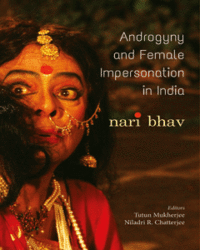 Nari Bhav, published by Niyogi Books, is a collection of essays exploring androgyny and female impersonation in India. These are fascinating insights by practitioners, interviews with actors and some academic papers discussing the concept of nari bhav is a deeply rooted cultural belief in the fluid interplay of the female and male symbolized for example as Ardhanariswara. A truly exceptional essay is the one by translator, performer and playwright, Pritham Chakravarthy, on performing the Nirvanam. This is the name of the performance she gave to a bunch of monologues that emerged from her work exploring the myth of Aravan that hijras or eunuchs have adopted in South India, especially Tamil Nadu, to contest the many filthy names used for them by the general public. To this she wove in the stories narrated to her by a transgender, ‘Noorie’. The first performance was staged in 2000 and was only ten minutes long. Years later she continues to perform it and the presentation is now forty minutes long and could probably be expanded to sixty minutes. Pritham Chakravarty makes a very interesting comment in her essay: “I sit among the audience and come to the central performance area to emphasize the ‘every
Nari Bhav, published by Niyogi Books, is a collection of essays exploring androgyny and female impersonation in India. These are fascinating insights by practitioners, interviews with actors and some academic papers discussing the concept of nari bhav is a deeply rooted cultural belief in the fluid interplay of the female and male symbolized for example as Ardhanariswara. A truly exceptional essay is the one by translator, performer and playwright, Pritham Chakravarthy, on performing the Nirvanam. This is the name of the performance she gave to a bunch of monologues that emerged from her work exploring the myth of Aravan that hijras or eunuchs have adopted in South India, especially Tamil Nadu, to contest the many filthy names used for them by the general public. To this she wove in the stories narrated to her by a transgender, ‘Noorie’. The first performance was staged in 2000 and was only ten minutes long. Years later she continues to perform it and the presentation is now forty minutes long and could probably be expanded to sixty minutes. Pritham Chakravarty makes a very interesting comment in her essay: “I sit among the audience and come to the central performance area to emphasize the ‘every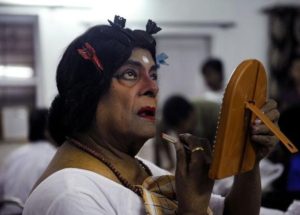 day-ness’ of the narrative that will presently unfold before their eyes.” And yet when Chapal Bhaduri, a Bengali actor famous for female impersonations, performed an autobiographical piece at a seminar organized at a Kolkata university in March 2016 it seems that members of the audience were discomfited by the performance.
day-ness’ of the narrative that will presently unfold before their eyes.” And yet when Chapal Bhaduri, a Bengali actor famous for female impersonations, performed an autobiographical piece at a seminar organized at a Kolkata university in March 2016 it seems that members of the audience were discomfited by the performance.
The concept was simple enough. The performance would be a companion piece to the 1999 documentary on him called Performing the Goddess [ made by Naveen Kishore, Seagull]. In the documentary, entirely shot in the modest ground-floor apartment in north Kolkata where he lives with his son, daughter-in-law and granddaughter of his sister Ketaki Dutta, Chapal Bhaduri gradually transforms himself from Chapal Bhaduri to Chapal Rani, from a man to a woman, from a human to a goddess, from the ordinary to the spectacular. At the seminar he would be doing the reverse. Her would appear before the audience as the Goddess Sitala, and then gradually divest himself of the divinity, the feminity, the spectacular, and end the piece by becoming what he is off-stage: human, male, ordinary.
While discussing the book with a dear friend I discovered some very interesting facts about his family. This friend 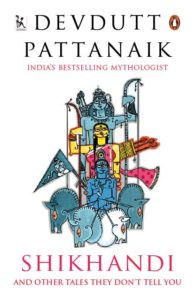 has often told me how there has always been a space in the Indian society for all genders including for the currently fashionable term — “gender fluid” individuals. When I showed him a picture of Chapal Bhaduri, he told me about his grand-uncle whom everyone in the family called “Dada” and had remained a bachelor all his life. He died a few years ago. Interestingly Dada used to be an usher at some “talkies” in CP or Old Delhi but was always fascinated by dancing and dressing up as a woman. Apparently he was the go-to
has often told me how there has always been a space in the Indian society for all genders including for the currently fashionable term — “gender fluid” individuals. When I showed him a picture of Chapal Bhaduri, he told me about his grand-uncle whom everyone in the family called “Dada” and had remained a bachelor all his life. He died a few years ago. Interestingly Dada used to be an usher at some “talkies” in CP or Old Delhi but was always fascinated by dancing and dressing up as a woman. Apparently he was the go-to 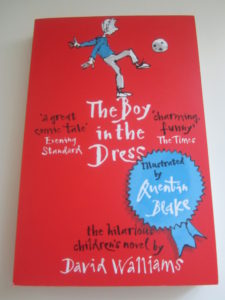 man in the family for advice on shringar, saris, buying gold jewellery etc. Dada was extremely fond of wearing beautiful Benarasi saris and spent a great part of his meagre salary to amass quite a collection. While still a young man he began dressing up as a woman. It seems he used to give performances at private gathering. Apparently Dada was very informed about mudras and used to be a delight to watch. Also the family was completely at ease with his gender identity. Apparently he was considered one of the respected elders of the family and his advice was sought on all important matters. He was also the matchmaker of the community. It probably also explains the comfort family members had with the eunuchs who used to wander in the colony.My friend has childhood memories of having the eunuchs over at home for tea and snacks. It was a regular affair and everyone was at ease with this practice. Another anecdote he recounts is of attending a wedding where where three uncles of the bride dressed up as women in saris and danced as part of the festivities.
man in the family for advice on shringar, saris, buying gold jewellery etc. Dada was extremely fond of wearing beautiful Benarasi saris and spent a great part of his meagre salary to amass quite a collection. While still a young man he began dressing up as a woman. It seems he used to give performances at private gathering. Apparently Dada was very informed about mudras and used to be a delight to watch. Also the family was completely at ease with his gender identity. Apparently he was considered one of the respected elders of the family and his advice was sought on all important matters. He was also the matchmaker of the community. It probably also explains the comfort family members had with the eunuchs who used to wander in the colony.My friend has childhood memories of having the eunuchs over at home for tea and snacks. It was a regular affair and everyone was at ease with this practice. Another anecdote he recounts is of attending a wedding where where three uncles of the bride dressed up as women in saris and danced as part of the festivities.
And he is not alone in his observations. Anita Roy, publisher and author, wrote this wonderful article in 2006 “Dancing with God” to witness the kōla ceremony; a puja that honours the village deity. ( http://bit.ly/2enwIcW)
Each family in the village undertakes to host this ritual every year. The presiding bhuta of Adve is Jhumadi (or Dhumavati in the local language, Tulu). A protector of the village and its inhabitants, human, animal and plant, Jhumadi is gendered female and believed to be one of the manifestations of the Goddess Shakti. But like Shiva’s incarnation as Ardhanariswara, she mixes both male and female attributes. Unlike the Puranic gods, who are worshipped in temples, officiated by Brahmin priests and receive offerings as silent spectators, bhutas are more localized spirits who directly influence the lives of their devotees with whom they have a much more intimate, almost neighbourly, relationship.
 At the Myrin International Children’s Festival, Reykjavík, well-known author and translator, Lawrence Schimel
At the Myrin International Children’s Festival, Reykjavík, well-known author and translator, Lawrence Schimel 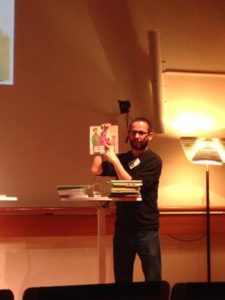 whose picture book for children, Amigos Y Vecinos, includes a gay family said that it’s extremely important to include LGBT+ characters in children’s books so they reflect the world that children already live in. (LILJA KATRÍN GUNNARSDÓTTIR, 6 Oct 2016 “LGBT lives just as important as heterosexual ones” http://bit.ly/2fgwEJE ) David Walliam’s first book for children The Boy in the Dress, Alex Gino’s incredibly powerful novel for young adults —George and Richa Jha’s picture book The Unboy Boy are examples of contemporary literature being inclusive by accepting and respecting “unconventional” characters for who they are. Vivek Tejuja, book critic, wrote a poignant article last year entitled “Being gay: how books and reading saved
whose picture book for children, Amigos Y Vecinos, includes a gay family said that it’s extremely important to include LGBT+ characters in children’s books so they reflect the world that children already live in. (LILJA KATRÍN GUNNARSDÓTTIR, 6 Oct 2016 “LGBT lives just as important as heterosexual ones” http://bit.ly/2fgwEJE ) David Walliam’s first book for children The Boy in the Dress, Alex Gino’s incredibly powerful novel for young adults —George and Richa Jha’s picture book The Unboy Boy are examples of contemporary literature being inclusive by accepting and respecting “unconventional” characters for who they are. Vivek Tejuja, book critic, wrote a poignant article last year entitled “Being gay: how books and reading saved 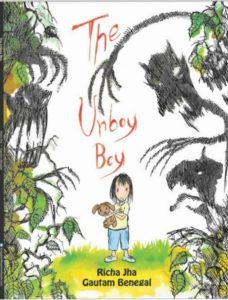 my life”. ( Scroll, 21 March 2015, http://bit.ly/2e1gb05)
my life”. ( Scroll, 21 March 2015, http://bit.ly/2e1gb05)
Reading provided the much needed solace. Reading was a balm to all my aches. Books transported me, took me away from reality. I did not know want to face reality. Why should I? I thought to myself, when I could be lost in the lands of Oz and travel with Gulliver and be miserable with Jane Eyre. Nothing was of consequence, but the authors and the books I read. . . . Reading books was sufficient then. They did not discriminate against me.
Vivek Tejuja’s forthcoming book meant for young adults will be addressing some of these issues. Siddharth Dube’s precisely told memoir No One Else and A. Revathi’s gripping account of her life as an activist in A Life in Trans Activism are recent contributions to Indian literature discussing sexuality and the grey areas it inhabits —these exist in Nature. 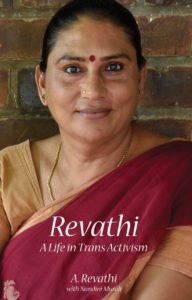 The biggest challenge lies in making this reality visible for now the hypocritic notion that heterosexuality is the norm and everything else is unacceptable on any moral compass reigns supreme. And yet as mythologist Devdutt Pattanaik confirms in Shikhandi and other tales they don’t tell you which is a collection of stories celebrating life “narrated by our ancestors that are rarely retold publicly as they seem to challenge popular notions of normality”. In Oct 2016, Parmesh Shahani, Head – Godrej India Culture Lab, said at the India Economic Summit, New Delhi that
The biggest challenge lies in making this reality visible for now the hypocritic notion that heterosexuality is the norm and everything else is unacceptable on any moral compass reigns supreme. And yet as mythologist Devdutt Pattanaik confirms in Shikhandi and other tales they don’t tell you which is a collection of stories celebrating life “narrated by our ancestors that are rarely retold publicly as they seem to challenge popular notions of normality”. In Oct 2016, Parmesh Shahani, Head – Godrej India Culture Lab, said at the India Economic Summit, New Delhi that 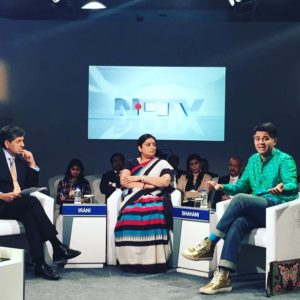 “inclusion is for everyone and not just the LGBT community”. He bolstered it with evidence that if businesses & institutions are inclusive then it will have a positive impact on productivity, growth and development. ( “India Economic Summit: Breaking Down Diversity Barriers”, 6 Oct 2016. http://bit.ly/2enrUoa )
“inclusion is for everyone and not just the LGBT community”. He bolstered it with evidence that if businesses & institutions are inclusive then it will have a positive impact on productivity, growth and development. ( “India Economic Summit: Breaking Down Diversity Barriers”, 6 Oct 2016. http://bit.ly/2enrUoa )
( Note: All the images are off the internet. If you own the copyright please let me know and I will acknowledge it. )
2 November 2016
